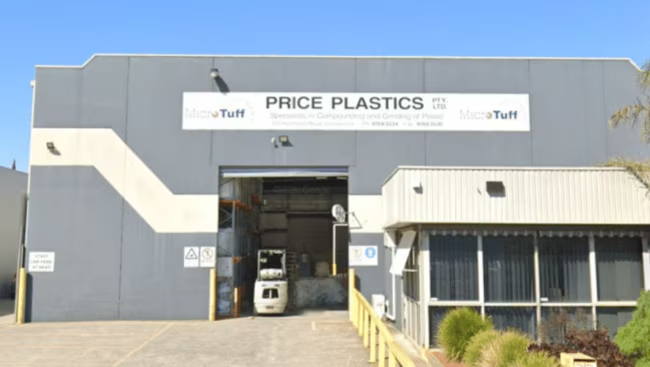
The closure of another Australian factory might barely register in the news cycle these days, but the collapse of Price Plastics tells a story that should concern every Australian—especially those who remember when this country actually made things.
After more than two decades manufacturing plastics and moulded products, Price Plastics has joined a sobering statistic: around 1400 manufacturers have collapsed since 2022-23.
The West Gosford and Caboolture-based company owes close to $4 million to suppliers and $641,000 to its 24 former workers, but its demise represents something far more significant than another business failure.
The brutal reality facing Australian manufacturers
The last twelve months have been a very difficult time to be in Australian manufacturing. The industry entered recession around the middle of 2024, and contracted 2.6 per cent over the last year.
While weak economic conditions in Australia have proven difficult for most industries, manufacturing has declined faster and further than any of its peers.
Price Plastics' administrators from KPMG cited a familiar litany of pressures: rising costs, overseas competition, supply chain disruptions, and the departure of key customers to cheaper rivals.
Revenue plummeted from $41.9 million in 2023 to just $25.8 million this year. The final blow came from a Malaysian competitor offering cheaper alternatives, capturing market share throughout 2025.
'Manufacturing has declined faster and further than any of its peers'
But Price Plastics wasn't alone in facing these challenges. Oceania Glass, Australia's only architectural glass firm, closed down in March 2025 after 169 years of operation.
The company that had survived two world wars, the Great Depression, and countless economic upheavals finally succumbed to the same pressures facing Price Plastics.
The energy crisis killing Australian manufacturing
At the heart of Australia's manufacturing crisis lies a policy failure that hits every Australian in the pocket: soaring energy costs.
East Coast gas prices have tripled since liquified natural gas (LNG) exports commenced out of Gladstone eleven years ago, which has driven corresponding rises in electricity prices.
For energy-intensive manufacturers like plastics companies, these costs have become unsustainable. Oceania Glass required a significant amount of energy, particularly gas, to power its 2000-tonne furnace at the heart of its Victorian operations.
As East Coast gas and energy prices skyrocketed, the company's profitability plummeted alongside its viability.
Australia's manufacturing decline in numbers
Manufacturing now represents just 5.1 per cent of GDP, down from 14 per cent in the late 1970s
Australia has the lowest manufacturing share in the OECD
The sector employs 930,000 people and produces $137 billion in output
Around 1,400 manufacturers have collapsed since 2022-23
The irony is stark: Australia has ample energy resources, yet its power costs remain among the highest in the world. We're literally exporting our competitive advantage while our own manufacturers struggle to survive.
The Asian competitive tide
While Australian manufacturers grapple with crushing energy costs, their Asian competitors enjoy significant structural advantages.
The Malaysia Plastics Market size is expected to reach USD 4.04 billion in 2025 and grow at a CAGR of 3.91 per cent to reach USD 4.90 billion by 2030.
Major markets for Malaysian plastic exports are the United States, European Union, Singapore, Australia and Japan.
Malaysian manufacturers are actively targeting the Australian market, offering products at prices that local companies simply cannot match given their cost structures.
For Price Plastics, the Malaysian competition proved decisive. After struggling with higher material costs and supply chain disruptions, the company found itself unable to compete when the Malaysian rival undercut their prices throughout 2025.
What this means for Australian communities
The human cost of manufacturing decline extends far beyond the factory floor. Manufacturing employs 930,000 people across Australia, supporting hundreds of thousands of families and entire regional communities built around industrial activity.
When Price Plastics closed, 24 workers lost their jobs. While administrators expect employee entitlements to be paid by December, these workers join thousands of others who've seen their livelihoods disappear as Australia's manufacturing base erodes.
The broader implications of manufacturing decline
- Loss of well-paying jobs in regional communities
- Increased dependence on imports for essential goods
- Reduced economic resilience during global supply chain disruptions
- Loss of technical skills and industrial knowledge
- Weakened national security through import dependence
The ripple effects reach into every household. Domestically made building material costs will also rise, making it more expensive to build homes and harder to meet housing supply targets.
As Australian manufacturers close, we become increasingly dependent on imports for everything from building materials to essential goods.
A rescue still possible?
Despite the bleak outlook, there's still hope for some Australian manufacturers. KPMG has received a rescue proposal for Price Plastics and is reviewing whether it could deliver returns to creditors.
The administrators have delayed the second creditors' meeting by up to 45 business days while considering the proposal.
But individual rescues won't solve the systemic problems destroying Australian manufacturing.
The Albanese government must emulate the Coalition's gas reservation policy. Otherwise, Australia faces soaring energy costs, higher inflation, and further deindustrialisation.
The path forward
For Australians who remember when this country manufactured cars, appliances, and countless other products domestically, the current situation represents a profound loss of economic sovereignty.
We've gone from being a nation that made things to one increasingly dependent on imports for basic necessities.
A nation so utterly dependent on others for manufactured goods is not a serious country.
The question facing Australia is whether we're prepared to take the policy steps necessary to reverse decades of manufacturing decline, or whether we'll continue to watch our industrial base disappear one factory closure at a time.
The Price Plastics workers deserve better than becoming another statistic in Australia's manufacturing decline.
More importantly, the country deserves an energy and industrial policy that gives our manufacturers a fighting chance against international competition.
What are your thoughts on Australia's manufacturing decline? Have you or your family been affected by factory closures in your area? Share your experiences and opinions in the comments below.
Primary Source
https://www.skynews.com.au/business...n/news-story/6e2bef14d136db4a20d4168b5b2e0a8d
How Australia killed it's manufacturing industry—MacroBusiness
Cited text: According to ASIC, around 1400 manufacturers have collapsed since 2022-23.
Excerpt: around 1400 manufacturers have collapsed since 2022-23
https://www.macrobusiness.com.au/2025/05/how-australia-killed-its-manufacturing-industry/
Research Note: Hard times in Australian manufacturing
Cited text: The last twelve months have been a very difficult time to be in Australian manufacturing.
Excerpt: The last twelve months have been a very difficult time to be in Australian manufacturing.
https://www.aigroup.com.au/resource.../2025/hard-times-in-australian-manufacturing/
Research Note: Hard times in Australian manufacturing
Cited text: The industry entered recession around the middle of 2024, and contracted 2.6 per cent over the last year. While weak economic conditions in Australia have pro...
Excerpt: The last twelve months have been a very difficult time to be in Australian manufacturing.
https://www.aigroup.com.au/resource.../2025/hard-times-in-australian-manufacturing/
How Australia killed it's manufacturing industry—MacroBusiness
Cited text: Oceania Glass, Australia’s only architectural glass firm, closed down in March 2025 after 169 years of operation.
Excerpt: Oceania Glass, Australia's only architectural glass firm, closed down in March 2025 after 169 years of operation.
https://www.macrobusiness.com.au/2025/05/how-australia-killed-its-manufacturing-industry/
How Australia killed it's manufacturing industry—MacroBusiness
Cited text: One of the recent causes of Australian manufacturing decline has been soaring energy costs on the East Coast of Australia. ... East Coast gas prices h...
Excerpt: East Coast gas prices have tripled since liquified natural gas (LNG) exports commenced out of Gladstone eleven years ago, which has driven corresponding rises in electricity prices.
https://www.macrobusiness.com.au/2025/05/how-australia-killed-its-manufacturing-industry/
How Australia killed it's manufacturing industry—MacroBusiness
Cited text: ... Oceania Glass required a significant amount of energy, particularly gas, to power its 2000-tonne furnace at the heart of its Victorian operations....
Excerpt: Oceania Glass required a significant amount of energy, particularly gas, to power its 2000-tonne furnace at the heart of its Victorian operations.
https://www.macrobusiness.com.au/2025/05/how-australia-killed-its-manufacturing-industry/
Manufacturing in Australia is in terminal decline—Frontline
Cited text: Australia has ample energy resources, yet its power costs remain among the highest in the world.
Excerpt: Australia has ample energy resources, yet its power costs remain among the highest in the world.
https://frontline.asn.au/news/manufacturing-in-australia-is-in-terminal-decline/
Malaysia Plastics Market Size | Mordor Intelligence
Cited text: The Malaysia Plastics Market size is expected to reach USD 4.04 billion in 2025 and grow at a CAGR of 3.91 per cent to reach USD 4.90 billion by 2030.
Excerpt: The Malaysia Plastics Market size is expected to reach USD 4.04 billion in 2025 and grow at a CAGR of 3.91 per cent to reach USD 4.90 billion by 2030.
https://www.mordorintelligence.com/industry-reports/malaysia-plastics-market
Malaysia Plastics Industry
Cited text: Major markets for Malaysian plastic exports are the United States, European Union, Singapore, Australia and Japan.
Excerpt: Major markets for Malaysian plastic exports are the United States, European Union, Singapore, Australia and Japan.
https://www.trade.gov/market-intelligence/malaysia-plastics-industry
Research Note: Hard times in Australian manufacturing
Cited text: It is the sixth largest industry in Australia, producing $137 billion of output while employing 930,000 people.
Excerpt: Manufacturing employs 930,000 people
https://www.aigroup.com.au/resource.../2025/hard-times-in-australian-manufacturing/
How Australia killed it's manufacturing industry—MacroBusiness
Cited text: Domestically made building material costs will also rise, making it more expensive to build homes and harder to meet housing supply targets.
Excerpt: Domestically made building material costs will also rise, making it more expensive to build homes and harder to meet housing supply targets.
https://www.macrobusiness.com.au/2025/05/how-australia-killed-its-manufacturing-industry/
How Australia killed it's manufacturing industry—MacroBusiness
Cited text: Put simply, the Albanese government must emulate the Coalition’s gas reservation policy. Otherwise, Australia faces soaring energy costs, higher infla...
Excerpt: The Albanese government must emulate the Coalition's gas reservation policy. Otherwise, Australia faces soaring energy costs, higher inflation, and further deindustrialisation.
https://www.macrobusiness.com.au/2025/05/how-australia-killed-its-manufacturing-industry/
Australia’s manufacturing sector bogged deep in recession | Nucleus Wealth
Cited text: A nation so utterly dependent on others for manufactured goods is not a serious country.
Excerpt: A nation so utterly dependent on others for manufactured goods is not a serious country.
https://nucleuswealth.com/articles/australias-manufacturing-sector-bogged-deep-in-recession/







